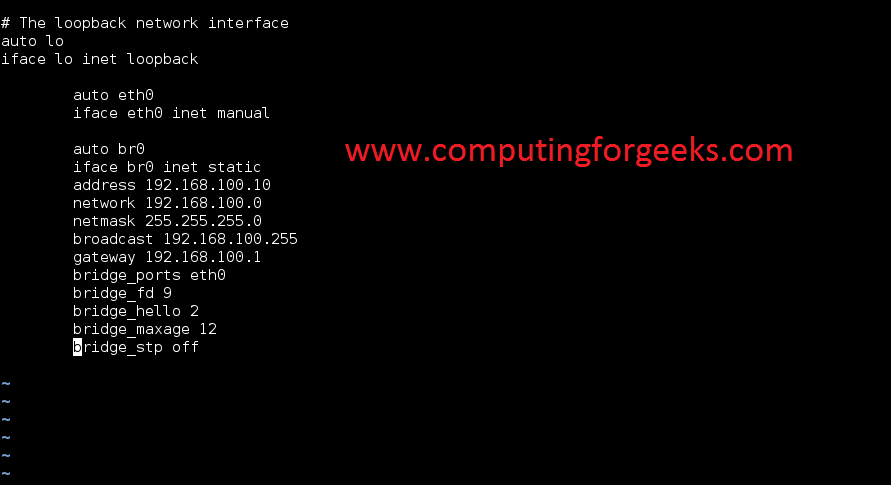Virtualization on both Ubuntu and Ubuntu Desktop made easier with Kernel-based Virtual Machine virtualization infrastructure for the Linux Kernel.
Virtualization is the hottest trending topic in system Administration nowadays. Virtualization is what allows you to create multiple instances of an operating system all running on same hardware. Each virtual machine is allocated hardware resources hence good hardware resource utilization.
We had talked about Virtualbox Installation on Linux. Today we'll go trough installation of KVM. KVM is a free software whose support is directly build into Linux kernel.It is supported by all Linux distributions. KVM turns Linux Kernel into a hypervidor.
Requirement is only processor that support virtualization.To confirm whether your Processor has virtualization extensions run the following command
Install required packages
In our example we'll bridge Ethernet eth0 interface.
So that it looks like one below.
![]()
Change inet mode from static to manual . It will look something like this.
Then restart Network daemon.
Confirm the newly created bridge interface with the command
Go to Menu-->File-->Remote tunnel over ssh.
Make sure Qemu is selected hypervisor and then type hostname for KVM server and the click connect.
Virtualization is the hottest trending topic in system Administration nowadays. Virtualization is what allows you to create multiple instances of an operating system all running on same hardware. Each virtual machine is allocated hardware resources hence good hardware resource utilization.
We had talked about Virtualbox Installation on Linux. Today we'll go trough installation of KVM. KVM is a free software whose support is directly build into Linux kernel.It is supported by all Linux distributions. KVM turns Linux Kernel into a hypervidor.
Requirement is only processor that support virtualization.To confirm whether your Processor has virtualization extensions run the following command
egrep '(vmx|svm)' /proc/cpuinfoIf you get any output then you are good to proceed.
Install required packages
sudo apt-get install qemu-kvm libvirt-binAdditionally, you can install ubuntu-vm-builder.
sudo apt-get install ubuntu-vm-builderAdd your user account to libvirtd group. This user will have the privileges to fire up Virtual Appliances.Replace "username" with your actual username.
sudo adduser "username" libvirtTest whether KVM is functioning and that your user account can manage it, virsh command is used for this purpose.
virsh -c qemu:///system listif you want your Virtual machines to communicate with machines outside KVM host, you'll have to set up bridged networking so that your Virtual Machines will appear to be on same network as your host.
In our example we'll bridge Ethernet eth0 interface.
Bridging eth0 interface using DHCP
sudo vi /etc/network/ interfaces.Look for the lines below,
auto eth0Change the inet mode for eth0 from dhcp to manual
iface eth0 inet dhcp
So that it looks like one below.
auto eth0Now add the following just below it.
iface eth0 inet manual
auto br0See below image
iface br0 inet dhcp
bridge_ports eth0
bridge_fd 9
bridge_hello 2
bridge_maxage 12
bridge_stp off

Bridging eth0 interface with Static IP address configured.
Look for the following lines,auto eth0
iface eth0 inet static
Change inet mode from static to manual . It will look something like this.
auto eth0Then add IP address information and bridging configurations just below it.
iface eth0 inet manual
auto br0See below image
iface br0 inet static
address 192.168.100.19
network 192.168.100.0
netmask 255.255.255.0
broadcast 192.168.100.255
gateway 192.168.100.1
bridge_ports eth0
bridge_fd 9
bridge_hello 2
bridge_maxage 12
bridge_stp off
Then restart Network daemon.
sudo /etc/init.d/networking restart
Confirm the newly created bridge interface with the command
sudo ifconfig -aTo manage your Virtual Machines with Graphical interface, install virt-manager
sudo aptitude install virt-managerTo start virt manager just tyupe the following command on terminal
sudo virt-managerVirt Manager can then be run on a host machine. It's not limited to local KVM management.You can install this package on another computer in your network then use ssh to connect to KVM Server.
Go to Menu-->File-->Remote tunnel over ssh.
Make sure Qemu is selected hypervisor and then type hostname for KVM server and the click connect.


